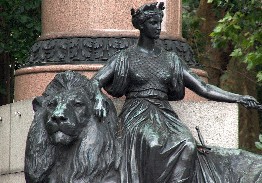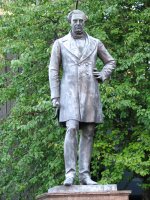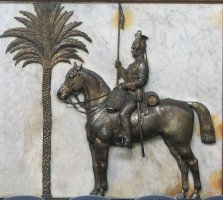Baron Carlo Marochetti RA (1805-1868)
Lion and company, by Marochetti.
The sculptor Carlo Marochetti was born in Turin, Italy, but lived for a time in Paris, where he made one panel for the Arc de Triomphe. At the onset of the Revolution of 1848, he settled in London. One of his earlest and most impressive works in this country is his Richard the Lionheart. This was shown at the Great Exhibition (placed outside as it was too large to enter the building) and a bronze version of 1860 is outside the House of Lords. His most important later work is the Albert and Victoria Tomb, Frogmore, with effigies of Albert (1868), Victoria (placed in 1901) and four angels. Marochetti's other works in London include Brunel on the Embankment, Stephenson (outside Euston Station - see picture below), Lord Clyde (Sir Colin Campbell) at Waterloo Place, the monument to Bazalgette, who built the Victoria Embankment, several monuments in St Paul's Cathedral (most notably the Viscounts Melbourne), and various busts in the National Portrait Gallery.
Marochetti also produced a variety of public sculpture elsewhere in England. These include two Wellington statues, in Stratfieldsaye, Hants, and in Leeds on Woodhouse Moor. A Lord Herbert of Lea is in Salisbury, Lord Clive in Shrewsbury, Joseph Locke is in Barnsley, and in Cambridge, Jonas Webb.
Stephenson.
Marochetti's work is predominantly portrait sculpture, with a few angels and representational figures for monumental works. It is careful, often noble, sometimes heroic as in the Richard the Lionheart, but rather cool in sentiment. The Britannia above, a rare ideal figure by Marochetti, illustrates this rather serious, hard edged feel to his work. He had no tendancy to classic dress, was perfectly at home with modern dress, and rather fond of the military figure.
Memorial sculpture by Marochetti.


